What is the context of Romans 1?
The context of Romans 1 is idolatrous worship
of false gods - not lesbians, not gays,
not homosexuality.
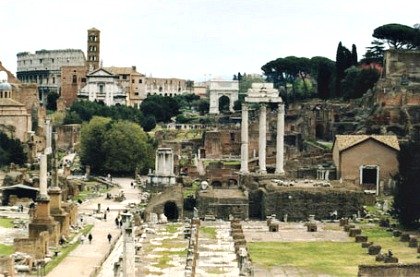 |
Pagan temples of ancient Rome
Romans 1 - I joyfully offer, in pdf format, my Romans Commentary and Study Guide Questions for you to make copies and use in your church or Bible study as long as you do not copyright it, sell it or claim it as your own work.
FREE - Romans Chapter 1 - 94 pages
FREE - Romans Chapter 2 - 34 pages
FREE - Romans Chapter 3 - 64 pages
FREE - Romans Chapter 4 - 89 pages
FREE - Romans Chapter 5 - 92 pages
FREE - Romans Chapter 6 - 62 pages
FREE - Romans Chapter 7 - 53 pages
FREE - Romans Chapter 8 - 113 pages
FREE - Romans Chapter 9 - 117 pages
FREE - Romans Chapter 10 - 75 pages
FREE - Romans Chapter 11 - 122 pages
FREE - Romans Chapter 12 - 105 pages
FREE - Romans Chapter 13 - 79 pages
FREE - Romans Chapter 14 - 104 pages
FREE - Romans Chapter 15 - 134 pages
FREE - Romans Chapter 16 - 121 pages
You are welcome to make copies of these pages to pass out FREE at your Bible study or church or other ministry. You may freely use these lessons in your Bible teaching ministry as long as you:
1. Do NOT Sell or Copyright these pdfs or the lessons, and
2. Do NOT Post this information or the pdfs online, and
3. Do NOT Claim these pdfs as your own work.
I have already copyrighted these pdfs and posted them online. May God bless as you enjoy studying His wonderful inerrant word!
Paul wrote his Epistle to the Romans
from the rowdy port city of Corinth, where sexual immorality and prostitution were openly practiced. Yet Rome was even more idolatrous than Corinth. Sporting events in the Circus Maximus and fertility goddess worship in pagan temples echoed the adulation of idolatrous Romans. Rome was a city wholly given to idolatry.
Context is important
To understand the Bible, we must
factor in the biblical, cultural, doctrinal, historical, linguistic and
religious context. In Romans 1:26-27, the context isn't two gay guys or
two gay gals who fall in love and covenant to spend their lives together
as a couple.
1. The biblical context is Paul making an argument against idolatry by summing up the Old Testament record of pagan Gentile worship, not homosexuality, not gays and lesbians, not transsexuals.
2. The cultural context is the greatest pagan city of the ancient world, an idolatrous tableau featuring hundreds of pagan temples where multitudes worshiped false gods.
3. The doctrinal context is righteousness.
God requires righteousness for salvation. We lack righteousness, as
evidenced by the pagan idolatry Paul references. God provides
righteousness as a free gift to everyone who wants it, including pagan
idolaters.
4. The historical context is mid-first century Rome about 25 years after the resurrection of Christ, where the main problem was idolatrous worship of false gods, not gays, not lesbians not trangendered people.
5. The linguistic context is Paul using the Greek word, akatharsian, in Romans 1:24 and 6:19, the same word used in the Greek Septuagint to describe idolatry and shrine prostitution.
Paul drives home his point by using the Greek word latreuō in v. 25, which we translate as, served. This word, in the Greek Septuagint, always refers to serving false gods. Paul used these words with purpose, to indicate he was referring to shrine prostitutes and their unholy worship of false gods.
Paul further drives home his point by using the phrase, arsenes en arsesin in v. 27 or men with men. This reminds us of arseno in Lev 18:22 and 20:13, clear references to shrine prostitutes.
6. The religious context is Cybele, the Phrygian mother goddess who was worshiped by temple prostitutes in at least six of Cybele's pagan temples in Rome in the mid-first century AD.
Understanding the Bible in context
is not:
a. changing the meaning of scripture
b. twisting scripture
c. re-interpreting scripture
d. taking scripture out of context
e. reading modern views into scripture
f. rewriting history
g. advocating lawlessness
h. attacking biblical holiness
i. eisogesic manipulation
Understanding and interpreting the Bible in context is standing for the historic truth of God by obeying 2 Timothy 2:15 and "rightly dividing the word of truth."
Think of it this way
Attempting to understand Romans without factoring in Cybele and shrine prostitution is as silly as trying to understand terrorism in New York City in September 2001 without factoring in the terrorist attack on the World Trade Center.
These Links explain Romans 1:26-27
1. Why is Cybele vital to understanding Romans? Part 1
2. Why is Cybele vital to understanding Romans? Part 2
3. Why is Cybele vital to understanding Rom@ns? Part 3
4. What does akatharsian mean in Rom@ns 1:24 and 6:19?
5. Are Romans and shrine prostitution historically linked?
6. Did Aristides in Ad 125-126, link Romans 1 to shrine prostitution?
7. What does against nature mean in Romans?
8. Will I go to hell because I am a lesbian and how can I know for sure?
9. How can we be sure what Paul was talking about in Rom@ns 1?
10. What words could Paul have used if he intended to condemn homosexuality?
11. Since gay couples cannot legally marry, is sex in a committed relationship sin?
12. When is it appropriate for a same sex couple to begin a sexual relationship?
13. Does Rom@ns 1:26-27 refer to heterosexuals acting like homosexuals?
14. Does Rom@ns say that God gives gay people over to homosexuality?
15. Does Rom@ns 1:26-27 condemn homosexuals?
16. Are lesbians treated the same as gays in the Bible?
17. Does Rom@ns 1:26 condemn lesbians?
18. How did you decide that Rom@ns 1:26 does not condemn lesbians?
19. How can you say that Rom@ns 1 has nothing to do with homosexuality?
20. Does likewise in Rom@ns 1:27 equate gay sex with lesbian sex?
21. How do you interpret Rom@ns 1:27?
22. Can you convince me that Rom@ns 1 is not talking about gays and lesbians?
24. What is justification by faith, part 2?
25. In scripture, idolatry in often linked to cultic sex rituals.
The testimony of history
about Romans 1
Early on, Christians understood that Paul, in Ro-mans 1, was writing about shrine prostitution. For example, the Christian preacher Aristides, within seventy years of the apostle Paul, taught that the issue Paul addressed in Romans 1 was idolatry and sexual worship of false gods. Christian apologist Justin Martyr, made the same point in the second century AD. That view is not gay revisionism. It is the record of history as the following authors remind us.
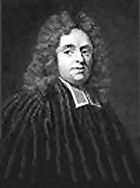 |
Matthew Henry
1662-1714,
Welsh Presbyterian minister
Three hundred years ago, Bible expositor Matthew Henry, linked Paul's idolatry argument in Ro-mans 1:27 to ancient Israel's idolatry and shrine prostitution. Believing that Paul was addressing shrine prostitution and idolatry is not gays trying to alibi our sin. It is basic Bible truth, taught by conservative Bible commentators and preachers for almost 2000 years.
"In Isaiah's time it (idolatry) abounded, witness the abominable idolatries of Ahaz (which some think are particularly referred to here - Isaiah 57) and of Manasseh.
1. They were dotingly fond of their idols, were inflamed with them, as those that burn in unlawful unnatural lusts, Ro-mans 1:27. They were mad upon their idols, Jeremiah 50:38. They inflamed themselves with them by their violent passions in the worship of them, as those of Baal's prophets that leaped upon the altar, and cut themselves, 1 Kings 18:26,28… Justly therefore were they given up to their own hearts' lusts. Matthew Henry's Complete Commentary on the Bible, Isaiah 57
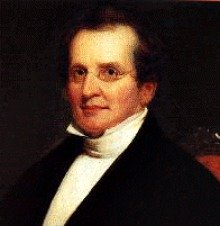 |
Charles Hodge
1797-1878,
Princeton Theological Seminary
On page 41 of his Commentary on Romans, commenting on Romans 1:26, Hodge writes:
“The reasons why Paul refers in the first instance to the sins of uncleanness, in illustration and proof of the degradation of the heathen, probably were, that those sins are always intimately connected with idolatry, forming at times even a part of the service rendered to the false gods."
A Geneva Series Commentary, A Commentary on Romans, by Charles Hodge, 1983 reprint (first published in 1835), Banner of Truth Trust, Carlisle, PA, p. 41.
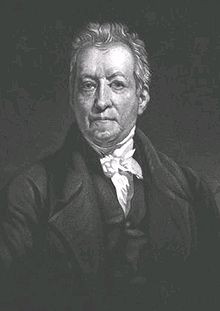 |
Robert Haldane,
1764-1842,
Scottish evangelist
Conservative Scottish Calvinist Robert Haldane, certainly not a supporter of gay rights, in 1835 wrote in his Commentary on Romans:
"The Apostle having awfully depicted the magnitude of Pagan wickedness, and having shown that their ungodliness in abandoning the worship of the true God was the reason why they had been abandoned to their lusts, here descends into particulars, for the purpose of showing to what horrible excesses God had permitted them to proceed.
This was necessary, to prove how odious in the sight of God is the crime of idolatry. Its recompense was this fearful abandonment. It was also necessary, in order to give a just idea of human corruption, as evinced in its monstrous enormities when allowed to take its course, and also in order to exhibit to believers a living proof of the depth of the evil from which God had delivered them; and, finally, to prove the falsity of the Pagan religion since, so far from preventing such excesses, it even incited and conducted men to their commission."
 |
Dr. Leon Morris
Ph.D.,
University of Cambridge
On page 89 of his Commentary on Romans, Dr. Morris writes:
“...there can be little doubt but that Paul is referring to the practice of ritual prostitution which was all but universal in the idolatrous systems of the first century... in the nature cults, for example, people thought that they had the secret of fertility. By the use of appropriate rituals (which included the sex act) they held that they could secure growth and vitality."
The Pillar New Testament Commentary, The Epistle to the Romans, by Dr. Leon Morris, 1988, Wm. B. Eerdmans Publishing Co, Grand Rapids, p. 89.
 |
Dr. Peter Ruckman
Ph.D.,
Bob Jones University
Dr. Ruckman, one of the most virulently anti-gay Baptist preachers, says Romans 1:26-27 describes activity that happened thousands of years before Paul wrote Romans. On pages 61-62 of his Commentary on Romans, Dr. Ruckman writes (bold emphasis in the original):
“...in Romans 1, the entire passage is talking about the Gentiles as a group. Notice verse 21: “when THEY knew God.” Verse 24: God also gave THEM up to uncleanness.” Verse 26: “God gave THEM up unto vile affections.” Verse 28: “Even as THEY did not like to retain God in their knowledge.”
So what you have in this passage is a history of the Gentile people when “God gave them over to a reprobate mind,” it had nothing to do with anything that took place in Paul’s day.
The passage is past history that took place before the time of Christ back in Genesis (chap. 11). That is when the “giving up” took place...
In the passage before us, God tested the Gentile nations on these points (vss. 26-32), and the Gentiles failed, as a group, on more than one occasion. So the Lord gave them up to the things which they were doing: he no longer dealt with them, as a whole, on the things listed in these verses...
But Paul said to the Athenians in Acts 17:30, “And the times of this ignorance God winked at; but NOW commandeth all men everywhere to repent.” So whatever the Lord did with the Gentiles in Romans 1, the death, burial, and resurrection of Jesus Christ changed all of that. God once more is dealing with the Gentiles, but on one issue-belief in His Son."
The Bible Believers Commentary Series, The Book of Romans, by Dr. Peter S. Ruckman, 2003, BB Bookstore, Pensacola, pp. 61-62.
The Circus Maximus in first century Rome seated 150,000 spectators. It was enlarged by Emperor Trajan after AD 98 to accommodate 250,000 spectators on marble seats. Its immense size, approximately 680 yards long and 160 yards wide, provided room for many spectacular events. The stadium could be flooded to provide a watery battleground for ships or drained for chariot races. Cybele's temple loomed atop the Palatine Hill above the upper right end of the Circus Maximus.
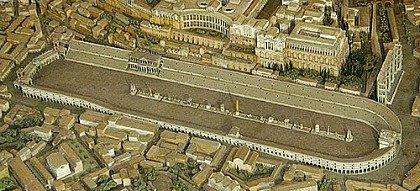 |
The Circus Maximus sports stadium
Throughout ancient Rome thousands of bronze and marble statues honored false gods. Carved friezes decorated building facades, depicting everything from daily activities to pagan gods. Wall, floor and ceiling murals in homes and commercial buildings depicted erotic sexuality.
Painted pottery portrayed
pornographic pictures
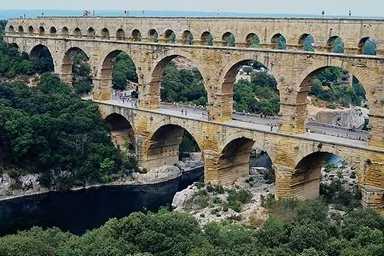 |
Roman aquaduct
Beyond the erotic and salacious, ancient Rome was an incredibly modern city. In the first century AD, six aqueducts, drawing on 130 outlying reservoirs, supplied water to homes and businesses and to 170 free public bath houses and 500 fountains.
Cybele's Temple in first century Rome is the historic and religious context Paul addressed
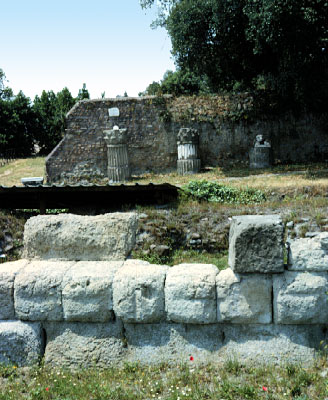 |
White stone steps, the ruins of Cybele’s Temple, on the Palatine Hill in Rome, where, in the first century, shrine prostitutes engaged in same sex prostitution to worship the fertility goddess.
"From a distance, the white stone steps caught the eye, making Cybele's Temple seem to float in the air."
Facing the Circus Maximus, crowning a long bank of white stone steps atop the Palatine Hill, the temple of Cybele loomed over first century Rome. The shrine prostitution practiced in Cybele's Temple is the specific historical context of Paul's letter to the struggling Christians in Rome.
Over the intervening 2000 years, the city has built up the land around the Palatine Hill so that today, it hardly seems like a hill. Much of ancient Rome is now buried under as much as 40 feet of fill dirt.
Prostyle Temple Design
According to the University of Chicago, Cybele's temple, the Temple of Magna Mater, was a prostyle, Roman
hexstyle, Corinthian temple, with columns across the front but unlike the
photo, without columns along the entire length of both sides.
"It
was decided to attribute the actual ruins to the Temple of the Magna
Mater [Cybele] because of the statue of the goddess found near the
edifice, and now in the close Domus Tiberiana, and to an inscription
found on the right side of the façade, that says: M(ater) D(eum) M(agna)
I(daea).
A coin of Faustina the elder confirms this, showing the
entire shape of this temple of Corinthian order. Another confirmation
is given by a relief of Claudian age, now at Villa Medici, with the
representation of the same facade."
On the edge of the Palatine
Hill the ruins of an ancient temple can still be seen. The Temple of the
Magna Mater, has been identified by archeologists as the temple of
Cybele through inscriptions honoring the Magna Mater (the Great Mother
of the gods).
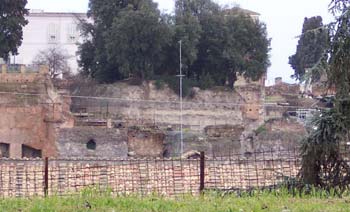
In Cybele's Temple, castrated, transvestite Galli priests offered themselves sexually to male worshipers. This pagan same sex activity is what Paul describes in Romans 1:27.
The Temple of Concord
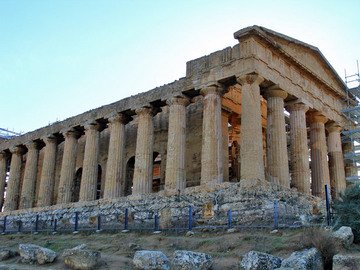
models an architectural style similar to Cybele’s Temple on the Palatine Hill in first century Rome. The primary difference between the Temple of Magna Mater (Cybele) on the Palatine Hill in first century Rome and the Temple of Concord is that Cybele’s Temple had six columns across the front (at the top of the white stone steps) but only three columns on each side. The white stone steps of Cybele's Temple (see earlier photo) are still visible today.
The cultic sexual activity in Cybele's Temple
does not equate to modern homosexuality anymore than rape equates to
modern heterosexuality.
1. Idolatry
2. Fertility goddess worship and
3. Shrine prostitution
frame the historical setting in which first century Christians received Paul’s letter to Rome. Paul does not mention or discuss lesbians or gay men in Romans 1. In Romans 1, Paul addressed a particular religious situation in the city of Rome. Traditionalists view Paul’s words in 1:26-27, especially the phrase against nature
as a universal prohibition of homosexuality, a generic prohibition of any and all homoerotic practice. This view ignores the context of Paul’s argument, the widespread written testimony of Christian preachers like Aristides and many commentators down the centuries and the most basic rule of hermeneutics.
Scripture cannot mean now
what it did not mean then.
Since Paul was referencing a particular pagan religious activity, shrine prostitution, in Romans 1, it is less than honest to reinterpret his words as if they suddenly refer to modern gays, lesbians, bisexuals or transgendered people. Paul’s words in Romans 1 are neither generic nor theoretical.
In Romans 1, Paul addressed a real situation faced by Christians in first century Rome. He was not making a sweeping condemnation of any and all same sex activity, divorced from the historical and religious context of his argument against idolatry.
Idolatry was the issue and Paul used idolatry to illustrate the lost condition of the heathen, to prepare them to receive the glorious gospel of Christ. The gospel illustrates the wrath of God against sin and how God dealt with sin by Himself becoming the perfect sacrifice - God's holy passover lamb, Genesis 22:8, Exodus 12, Psalm 22, Isaiah 53, John 1:29, 1 Corinthians 5:7, Romans 3:25-26.
If Paul's words in Romans 1:26-27 were not a universal reference to homosexuality in the first century AD, then Romans 1:26-27 cannot be a universal reference to homosexuality today. Idolatry, not lesbians and gays, was the issue Paul addressed.
Reading into the text what Paul did not say, (a universal prohibition of homosexuality) is called eisogesis. That is the wrong way to interpret scripture. Modern "ignore the context" interpretation is unworthy of Christians who love the word of God.
Paul's words to the Christian community in ancient Rome come from his knowledge of the first century world in which he lived. His carefully tailored argument in Romans 1 is set in the specific context of Gentile and Jewish history, complete with first century illustrations familiar to first century readers.
Paul’s readers were intimately acquainted, as we are not, with Greek, Jewish and Roman culture and the shrine prostitution which permeated those ancient cultures.
Can we honestly deny the influence
of fertility goddess cults which
flourished in first century Rome?
As residents of the Imperial City, ancient Romans personally witnessed thousands of statues of false gods, hundreds of pagan temples and pagan worshipers thronging the grand streets for religious festivals. Commentators who ignore the historical and religious context of Romans 1 entirely miss the point of Paul's argument against idolatry and shrine prostitution.
Fertility goddess worship and shrine prostitutes flourished in first century Rome. That is precisely what Paul addressed in Romans 1. Attempts by non-gay Christians to divorce Romans 1 from its historical context are due more to their support of an anti-gay agenda than a desire to honestly understand Romans 1.
This Spanish fountain, honoring Cybele, pagan fertility goddess of ancient Rome, depicts Cybele riding in her chariot pulled by lions.
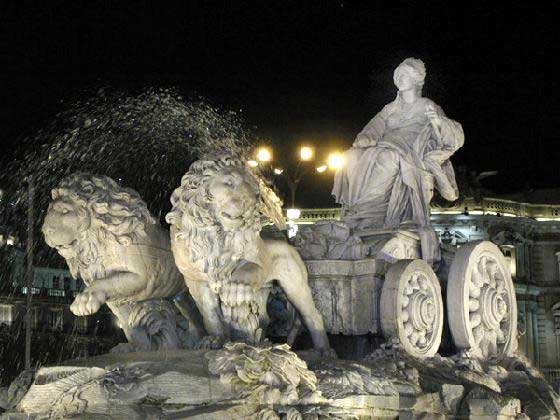
Historical facts are a wonderful antidote for ignorance. Cybele the fertility goddess was worshiped throughout the Roman Empire and was also depicted on Roman coins. It is impossible to separate Paul's words in Romans 1 from the fertility goddess worship that permeated first century Rome.
In the heart of Rome, a temple to Cybele was constructed in 194 BC. When fire destroyed the original temple, Augustus rebuilt it in 3 BC. Cybele, a prominent first century fertility goddess, was sometimes called (Magna Mater) or Great Mother and (Mater Deum) or Mother of the gods. First century Romans worshiped her as the Sacred Protectress of Rome.
Ancient Roman coins testify to Cybele's widespread influence
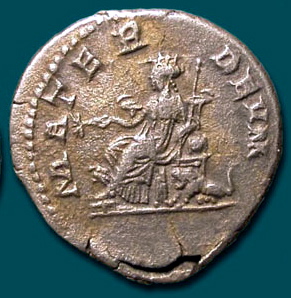
Cybele, on this ancient Roman coin, is called Mater Deum, "Mother of the gods." By the mid-first century AD, when Paul wrote Romans 1, the Cybele cult was one of the most powerful in the Roman Empire. Cybele worship included orgiastic sexual rites and ritual blood-letting by Galli priests and priestesses, similar to the practice of Baal worshippers in the Old Testament.
Some priests, accompanied by wild music and frenetic dancing, castrated themselves. In the first century AD, religious festivals honoring Cybele were celebrated in the streets. Castrated long haired priests preceded the image of the goddess, beating drums and cymbals, showing off their colorful clothing.
Who were the unholy
priests of Cybele?
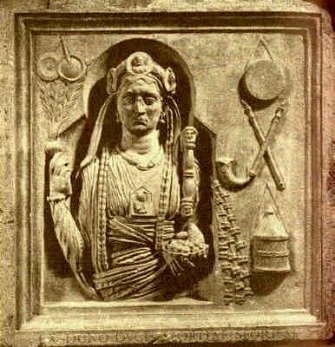
Bas relief of an Archi-galli priest or a head priest. The priests of Cybele were called gallus or galli, referring to their man-made eunuch status. They were physically castrated to further their sexual service to the fertility goddess. Male worshipers would engage in anal sex with the priests, as an offering to the goddess. This is the shameful activity Paul refers to in Romans 1:27.
"Galli, castrated male eunuch priests, were found in many goddess cults. They functioned as representatives of the goddess, offering themselves sexually to male worshippers. These religious practices flourished in first century Rome."
A Dictionary Of Greek And Roman Antiquities, Third Edition, Appleton, 1874, p. 566, Galli definition.
The ancient fertility goddess
had many names

G. Rattray Taylor,
1911-1981
British author
“The religions which developed these ideas were all based on a maternal figure, found under different names throughout a great part of the Near East.
To the Phoenicians she was Astarte; to the Phrygians, Cybele; to the Babylonians, Ishtar; to the Thracians, Bendis; to the Cretans, Rhea; to the Ephesians, Artemis; to the Canaanites, Atargatis; to the Persians, Anaitis; to the Cappadocians, Ma. But though her names differ, her attributes are the same - she is always the mother who succours and helps, and who bestows fertility.
This composite figure was generally known as Magna Mater, the great mother, and it was said that she was mother of all the other gods...
‘On certain days a multitude flocks to the temple, and the Galli in great numbers, sacred as they are, perform the ceremonies of the men and gash their arms and turn their backs to be lashed (I Kings 18:28).
Many bystanders play on the pipes, while many beat drums; others sing divine and sacred songs. All this performance takes place outside the temple... As the Galli sing and celebrate their orgies, frenzy falls on some of them, and many who had come as mere spectators afterwards are found to have committed the great act (self castration).”
Sex In History, Gordon Rattray Taylor, 1954, Book 3, ch 12.
Idolatry and shrine prostitution are
what Paul addressed in Romans 1,
not homosexuality and lesbianism.
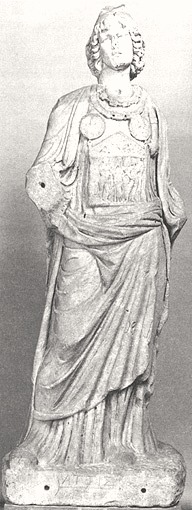
Statue of a Galli priest.
Paul grounds his Romans 1 argument in historical fact, explaining what Christians witnessed in Rome every day, the idolatry and shrine prostitution which surrounded worship of false gods.
For a more detailed study of Romans 1, with many Links to additional info,
please visit:
Jeramy Townsley's fascinating website.
Gay Christian 101 Home Page
Google Translate
into 90 languages
We are saved:
by grace alone through faith alone
Recent Articles
-
Gay Christian 101 - Affirming God's glorious good news for all LGBs.
Jan 08, 24 12:57 AM
Gay Lesbian Bisexual Christian 101 - Accurate biblical and historical info defending LGB Christians from the anti-gay crowd. -
Romans 1 describes ancient shrine prostitution, not gays and lesbians.
Dec 21, 23 04:37 PM
Romans 1, in historical context, is about ancient Roman fertility goddess worshipers who engaged in shrine prostitution to worship Cybele, not gays and lesbians. -
The Centurion And Pais - When Jesus Blessed A Gay Couple.
Nov 14, 23 10:32 PM
Centurion and Pais? If Jesus blessed a gay relationship, would this change your view of homosexuality?
Bible Study Resources
for eDisciples



